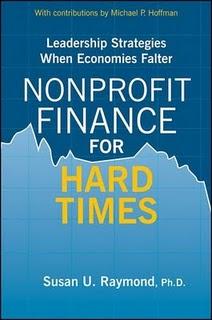Nonprofit Finance for Hard Times: Leadership Strategies When Economies Falter

Did you know there are over twenty-five IRS codes for nonprofits? Or that nonprofits make up the third largest sector in the US economy? Or that more than three quarters of the existing nonprofits have emerged since 1980? Given that this is such a large sector to examine and there are imperfections in available data, Susan Raymond limits the scope of her new book, Nonprofit Finance for Hard Times, to discussion of organizations with 501(c)(3) status.
The 501(c)(3) category includes organizations focused on myriad areas, including religion, education, testing for public safety, fostering national or international amateur sports competition, and prevention of cruelty to children or animals. Some examples of 501(c)(3) organizations you are probably familiar with are The Boys & Girls Club, The United Way, and the publisher of Bitch magazine, Bitch Media. I personally appreciated this limitation in scope since I work for a 501(c)(3) nonprofit and could think about the arguments and tips in terms of how they can be of use to my particular agency.
Nonprofit Finance for Hard Times provides recommendations of strategies for revamping or revitalizing existing programs while engaging and strengthening relationships with donors, foundations, and other financial stakeholders. The text extensively discusses not only the ways to make it through economic hardship but also how to best plan for the long term in ways that can buffer more difficult times. My personal favorite of these tips is the the importance of a strong and committed volunteer base. In times of economic hardship, people’s most valuable asset is their time, which can make or break an organization when money is tight.
I liked the layout of the book and appreciated the thematic summaries at the beginning of each chapter. These summaries helped me decide if the information in the chapter was going to be of any use or interest for my purposes. Raymond furthered supports her recommendations by providing many examples and testimonials, which help illustrate how theory is translated into practice and what some organizations found effective. One such testimony was from the CEO of (RED) on how cause-related marketing has helped raise funds to fight AIDS in Africa. You may have seen some of this cause-related marketing at Starbucks or The GAP.
Another point of interest for me was the tone of the discussion. Many of Raymond’s ideas are based off of what I consider to be corporate business models. Yes, nonprofits must raise funds to continue to provide their services, keep their doors open, and continue the work, but I believe grassroots organizing is a more effective approach. Strangely enough, this is not mentioned in Raymond’s book. I even checked the index in the back, thinking perhaps my brain had gone on autopilot and missed it, but ‘grassroots’ wasn't even listed.
I worry that not considering a ground-up approach to stabilize an organization’s operational model is forever going to be deeply tied to the booms and busts of our capitalist economy, and it is concerning that this book makes no mention of involving the people directly impacted by nonprofit nor does it consider the impact these people's needs, desires, and investment may have in supporting the organization. This crucial aspect was not explored by Raymond to its fullest potential.
Taken as just one perspective of many, this book could be quite useful to large nonprofits with a global vision. While I did not particularly enjoy the book, I do believe sharing of effective practices and strategies is necessary for the nonprofit sector of the economy, and that long term planning is the key to an agency’s survival during the hard times.